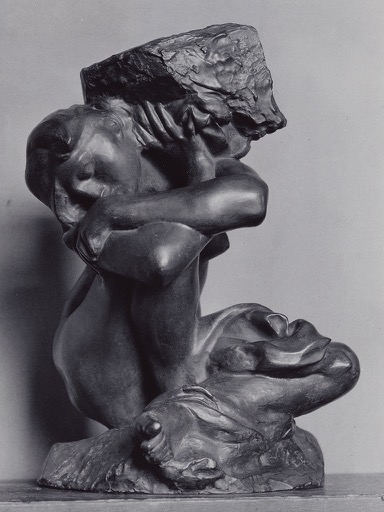Distinguishing

Auguste Rodin: The Fallen Caryatid Carrying Her Stone (Modeled 1881–82, cast 1902/24)
"HomeMaking is first about making the HomeMaker, then about making a home."
I'm unaccustomed to thinking of HomeMaking as a distinguished occupation, but like every occupation, HomeMaking involves making distinctions, Distinguishing. Considerable judgement also seems a necessary element of the effort, for a HomeMaker must do more than distinguish difference, but also determine if any intervention seems necessary and if so, how much. I imagine a huge chart denoting forms and degrees of engagement, something like: ©2021 by David A. Schmaltz - all rights reserved
If rough, smooth.
If smooth, texture.
And also listing the ten thousand primary elements of HomeMaking, but the pattern would quickly emerge as simple, and as fundamental as evolution:
If not right, fix or tolerate
If right, preserve or improve.
I catch myself in endless judgement of my surroundings, the better, I presume, to render them more properly like home. Not into Home but into more Home-like, an analogy. I perform this service by means of my Distinguishing. I exercise my judgement by first distinguishing. The quality of any resulting engagement feeds my judgement engine which might improve my Distinguishing. It all starts by noticing something. HomeMaking, like everything, utterly depends upon somebody first observing something.
There might only be five fundamental HomeMaking Distinguishing Elements: Context, Condition, Size, Shape, and Color. Each seems conditioned by taste or the lack thereof, for norms now seem nonexistent. Most anything can be justified by an untempered mind. Nor will even the HomeMaker maintain a consistent perspective about the property he purports to steward. His sense of proper will likely change over time, HomeMaking amounting to iterative approximation, sometimes actively undoing what was formerly insisted upon. Context remains king. A midcentury Rancher will not congruently redecorate into a turn of the century foursquare. The basement stairs effort, which this morning remains somewhere in the middle of a process of repainting, began with a simple distinction of Condition. The then-existing wallpaper was partially shredded and falling off the wall, clearly not right. After years of tolerance, I set about to fix that primary Distinguishing element, Condition. I then patched holes and prominent divots, smoothing roughness, or trying to. I still need to sand the result, but because it's a basement staircase, I needn't get all anal about that. Rough smooth should prove plenty smooth enough. A coat of smoothing primer over the whole mess, then I can rid this world of that awful color.
Through the whole process, I'm never really working on more than one distinction at any moment. Condition then color, iterating each in turn. I employ this same pattern in whichever aspect of HomeMaking I'm engaging. I notice, then start iterating. I'm consequently always either up to something or actively procrastinating from engaging. There's little middle ground. But what am I really doing, now that I've outlined my grand theory of HomeMaking in practice? One more distinction might suggest that the term HomeMaking amounts to a fundamental attribution error, and that my whole conception of a series focusing upon HomeMaking might have been misbegotten. Where could it go as proposed? Probably just where it went, to wind up proposing a grand overarching theory then run out of further utility. Where then? Nowhere again and again and again. It's probably not the home being made, but the purported HomeMaker. By attempting to Make Home, the aspiring or even practicing HomeMaker, makes himself. The home just serves as context and absorbs the evidence. What does it matter that the basement staircase is painted an electrocuted green or an intellectual grey? The painting matters much, much more than the color. The painting mattered because it served as the medium for the so-called HomeMaker to make himself all over again, again, and again again, making something different of himself.
I ran into some old demons when attempting that basement staircase painting and I experienced the opportunity of facing off with them again. With some, my history more than informs my engagement. Dry wall mud has forever been my sworn adversary. It's thwarted and humiliated me many, many times before. I do not understand its nature so I anticipate that it will work differently than it ever has. This iteration could serve as an opportunity for me to grow beyond those sorry introductions or not, depending upon me and how I choose to engage with the damned stuff. However I choose, please notice that it's the humble HomeMaker being remade, not so much the staircase. The staircase's context dictates that it remain pretty much just as it is, Context, Size, and Shape seem immutable. Neither Condition or Color improvements will actually transform this feature, but painting it could and very likely will improve the HomeMaker more than it improves the home being "made."
It might be true that any distinction says more about the one making it than it ever says about whatever's recognized as the distinction. Observers filter their perception through themselves first, such that each distinction first becomes a statement about the observer's preference. The home, made or not, simply provides a context within which the budding (always budding) HomeMaker might manage to make or remake himself. 'Twas always thus. Excuse me, please, if you feel that I mislead you with this series' topic. I mislead myself first. A distinction might make a significant difference once more properly focused. HomeMaking is first about making the HomeMaker, then about making a home. It could not possibly ever be otherwise.


